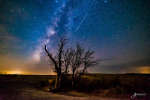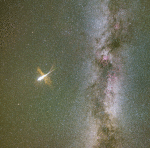
|
Astronomy Picture Of the Day (APOD)
 Comet Dust over Enchanted Rock
Comet Dust over Enchanted Rock
13.08.2015
Dusty debris from periodic Comet Swift-Tuttle was swept up by planet Earth this week. Vaporized by their passage through the dense atmosphere at 59 kilometers per second, the tiny grains produced a stream of Perseid meteors. A bright, colorful Perseid meteor flash was captured during this 20 second exposure.
 Moonless Meteors and the Milky Way
Moonless Meteors and the Milky Way
12.08.2015
Have you watched the Perseid meteor shower? Though the annual shower's predicted peak was last night, meteor activity should continue tonight (August 13/14), best enjoyed by just looking up in clear, dark skies after midnight. Of course, this year's Perseid shower has the advantage of being active near the August 14 New Moon.
 Milky Way and Exploding Meteor
Milky Way and Exploding Meteor
11.08.2015
Tonight the Perseid Meteor Shower reaches its maximum. Grains of icy rock will streak across the sky as they evaporate during entry into Earth's atmosphere. These grains were shed from Comet Swift-Tuttle.
 A Blue Moon Halo over Antarctica
A Blue Moon Halo over Antarctica
10.08.2015
Have you ever seen a halo around the Moon? Such 22 degree rings around the Moon -- caused by ice crystals falling in the Earth's atmosphere -- are somewhat rare. OK, but have you ever seen a blue moon?
 A Sagittarius Triplet
A Sagittarius Triplet
9.08.2015
These three bright nebulae are often featured in telescopic tours of the constellation Sagittarius and the crowded starfields of the central Milky Way. In fact, 18th century cosmic tourist Charles Messier cataloged two of them; M8, the large nebula left of center, and colorful M20 on the right.
 HCG 87: A Small Group of Galaxies
HCG 87: A Small Group of Galaxies
8.08.2015
Sometimes galaxies form groups. For example, our own Milky Way Galaxy is part of the Local Group of Galaxies. Small, compact groups, like Hickson Compact Group 87 (HCG 87) shown above, are interesting partly because they slowly self-destruct.
7.08.2015
By planet Earth's calendar, the Curiosity Mars Rover reached its 3rd anniversary on the surface of the Red Planet on August 6. To celebrate, gaze across this dramatic panoramic view of diverse terrain typical of the rover's journey to the layered slopes of Aeolis Mons, also known as Mount Sharp.
 Full Earth, Full Moon
Full Earth, Full Moon
6.08.2015
The Moon was new on July 16. Its familiar nearside facing the surface of planet Earth was in shadow. But on that date a million miles away, the Deep Space Climate Observatory (DSCOVR) spacecraft's Earth Polychromatic Imaging Camera (EPIC) captured this view of an apparently Full Moon crossing in front of a Full Earth.
 Stereo Pluto
Stereo Pluto
5.08.2015
These two detailed, true color images of Pluto were captured during the historic New Horizons flyby last month. With slightly different perspectives on the now recognizeable surface features they are presented in this first high quality stereo pair intended for viewing by denizens of planet Earth.
 X ray Echoes from Circinus X 1
X ray Echoes from Circinus X 1
4.08.2015
Circinus X-1 is an X-ray binary star known for its erratic variability. In the bizarre Circinus X-1 system, a dense neutron star, the collapsed remnant of a supernova explosion, orbits with a more ordinary stellar companion.
|
January February March April May June July August September October November December |
|||||||||||||||||||||||||||||||||||||||||||||||||